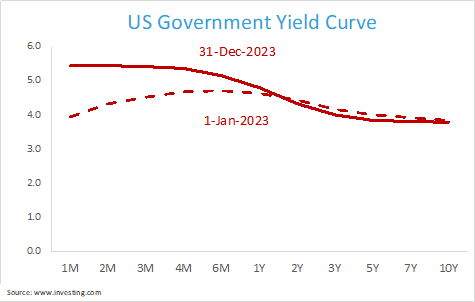
As a new year in financial markets begins, it’s probably fair to observe that for most economic forecasters or market strategists 2023 was a humbling year. This time last year a global recession was imminent, stocks and property would free fall, although China would come roaring back, and bonds were the place to be. But none of that happened…
This time last year the mood was glum as market forecasters surveyed the year ahead. In Australia Interest rates had risen from essentially zero the year before to start 2023 at 3.1% – and the one thing everyone agreed upon (and got it right) was that interest rates had further to go. Eight rate rises in less than a year could months only mean one thing – a recession was an inevitable consequence of such rapid fiscal tightening.
And there was good evidence to support this view – the shape of the US yield curve was a forebearer of a coming recession. Now yield curves are an esoteric part of financial markets, but they represent the bond markets view of future economic conditions. As the chart below shows at the start of 2022 the yield curve was “normal” – that is, an investor received a higher yield for buying bonds with a longer maturity, which is what one expects[1].
[1] Longer bonds ae more sensitive to changing interest rates and other unforeseen economic changes, and therefore one expects to be rewarded for taking on the additional risk of owning longer bonds compared to the more certainty of shorter bonds, which are more cash like.

But by the end of 2022 the yield curve was “inverted” – shorter bonds were delivering a higher yield than longer bonds[1]. Such an inversion has served as a relatively reliable recession indicator in the modern era[2]. A simple explanation is this: in the short term yields rise as interest rates go up, but this creates a recession which means longer term yields come down as central banks must cut interest rates to get GDP growth up off the floor.
Because yield curve inversions are relatively rare yet have often preceded recessions, market forecasters will say that a recession is now a foregone conclusion based on the shape of the curve – even if they can’t pinpoint how long after the inversion a recession begins.
Of course, the result of any economic recession would surely be that stocks will tumble – or so the forecasters told us. Technology stocks, which had already fallen by 30% in 2022, were predicted to fall further in 2023. High tech stocks are growth companies – those with high price to earnings ratios – and in theory these are more sensitive to interest rate changes than other stocks.
And for a moment, it looked like that was about to happen. Something indeed broke: Silicon Valley Bank and a few other lenders collapsed in March after suffering massive losses on fixed-income investments — a consequence of the rate hikes — and investors braced for an escalating crisis. Stocks fell and bonds rallied, but the panic didn’t last long. The Fed managed to quickly contain the crisis, and stocks once again moved higher, while unfortunately so did yields – pushing bond prices down.
The Nasdaq stocks have had an amazing run helped by the AI craze and are up a staggering 45% (in USD) in 2023, wiping out the bear market of 2022. This has helped push the broader US market to a return of 25.7% (in AUD) for the year. But the booming stock market is not confined to the US. Europe and Japan are both up over 19% (in AUD) for the year, helping drive the World (ex-Australia) index to its best return in four years.
[1] The usual measure of inversion is the 2 year bond yield minus the 10 year bond yield.
[2] Federal Reserve Bank of Chicago. “Why Does the Yield-Curve Slope Predict Recessions? https://www.chicagofed.org/publications/chicago-fed-letter/2018/404
The Australian sharemarket did spend most of the year in a holding pattern on concerns around inflation and interest rates, but in the last eight weeks of year the ASX added a stunning 12% as inflation data in November came in lower than expected. Overall, the ASX is up 12.4% for the year – its best return since 2022.
Furthermore, any recession would bring about a painful increase in unemployment, which coupled with the significant rise in mortgage repayments and the already higher cost of living, would have dire consequences for the property market. Certainly, there would have been few forecasters at the beginning of the year who believed that national house prices could rise 9% in 2023.
Towards the end of 2022 the Chinese government ended its strict Covid controls. With its economy unleashed, strategists were predicting a booming Chinese economy would help propel a rebound in emerging market stocks. But the world’s second biggest economy has faltered as a real-estate crisis deepened and fears of deflation grew. Rather than pile in, investors pulled out, sending Chinese stocks tumbling. The Chinese stock market is down -11.7% (in AUD) for the year, keeping the Emerging Market index at a modest 9.2% (in AUD) gain for 2023.
And finally, the “now is the time to be in bonds” story – which every fixed interest fund manager was pushing at the start of 2023 – wasn’t going so well either. By the end of October bond yields were peaking, and it appeared that fixed interest markets were heading for an historic third straight year of negative returns. Once again, the forecasters had got it completely wrong.
However, when the Fed announced in December that they were done raising rates and the next move would be downwards – the long awaited “pivot” – bond yields instantly started falling. The US yield curve was still inverted as shown below – but this time the narrative had changed. Rather than the inversion being due to a “hard landing”, now the inversion was just the market pricing in that inflation was under control and that interest rates would start coming down as the economy eased into a “soft landing”.

Certainly, there were very few backing the Fed’s chances of delivering a soft landing in early 2023, but so far, so good on that front. The economy has done better, and inflation has fallen faster than was expected. It turns out that the economy was far stronger and far better positioned to cope with higher interest rates than the economists and analysts had thought.
It’s fair to ask how these highly paid forecasters could get it so wrong. It turns out that the economy was far stronger and far better positioned to cope with higher interest rates than the economists and analysts had thought. Which just goes to show that the old adage “It’s difficult to make predictions – especially about the future”[1] still holds true.
When it comes to financial markets, no matter how compelling you think the data is, or how logical the outcome appears, the future is still unknowable. The best way to deal with market forecasts? Just ignore them. Stay disciplined in a diversified portfolio that has been designed to meet your needs and risk tolerance.
You might rightly ask what did these forecasters miss? A part of the answer is the extent to which fiscal policy supported growth, and the buffer that household savings provided to consumers. Locally, the impact of net migration helped to support house prices and the broader economy. But it also impacted inflation, as strong population growth added to already robust domestic demand.
Dr Steve Garth
January 2024
[1] A quote attributed to many people, from the Nobel prize-winning Quantum physicist Niels Bohr to legendary baseball player (and philosopher) Yogi Berra


